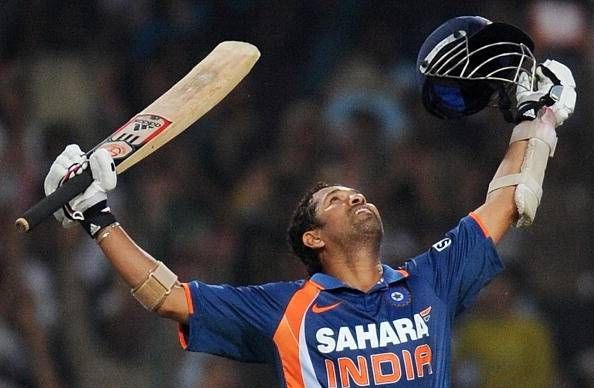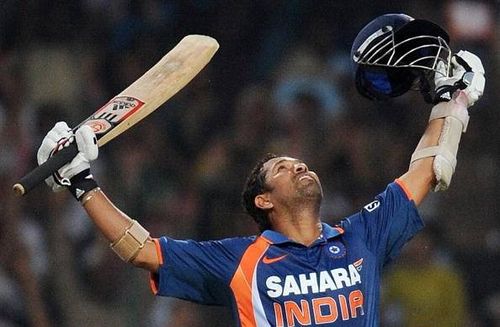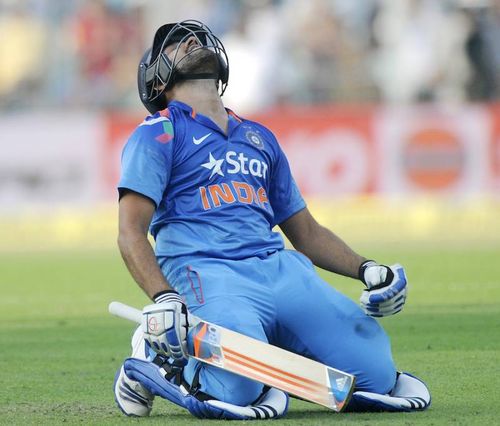
Has Rohit Sharma's 264 done more harm than good to Indian Cricket?

“And it’s the Superman from India.”
Long before he was caught up in the tussle of team meetings and selections as a director of the Indian cricket team, Ravi Shastri , in the confines of his commentary box, uttered the above words after one of the greatest cricketers of the modern era achieved a feat, that till then, had seemed unattainable in the world of cricket.
By steering South African Charles Langeveldt’s delivery for a single behind point, Sachin Ramesh Tendulkar became only the first international cricketer to notch up a double century in the One Day Format, touching a landmark which reinforced his supremacy in the game, if any was ever needed.
Almost 5 and a half years since 24th February 2010 when the first double ton was scored in Gwalior, the game has tilted majorly in favour of the batsmen, with rule changes that have made scoring runs easier than before. As of 30th June 2015, the individual score of 200 has been breached 5 times. Rohit Sharma did it twice, Virender Sehwag, Chris Gayle and Martin Guptill once each.
Rohit Sharma, often accused of being “consistently inconsistent”, despite a plethora of talent at his disposal, entered record books by becoming the first player in the world to notch up two double tons- his first, where he scored 209, on a flat pitch at the Chinnaswamy against the mighty Australians in 2013, and his second, a mammoth score of 264, on his favourite hunting ground Eden Gardens in Kolkata, facing the Sri Lankans, a year later.
As Rohit warded off stiff competition from Ajinkya Rahane by sealing the openers slot by virtue of his two historic knocks, the cricket pundits couldn’t help but point fingers at the smaller boundaries, heavier bats, two new balls in an innings and the fielding restrictions for making cricket a game which has swung away from the clutches of the bowlers.
Seeing the recent upsurge in the 400+ scores, the International Cricket Council (ICC), in its Annual Board Meeting held in Barbados earlier this month, in a bid to balance out the forces of the bat and ball, got rid of the compulsory Batting Powerplay, also permitting 5 fielders outside the 30 yard circle during the last 10 overs of an innings. The new rules will be effective from 5th July 2015.
But while the central body was quick to note the ill effects of the high scores, Indian cricket still seems to be reeling from the assault that Rohit had fired on the Angelo Mathews led team, almost 8 months ago, with a couple of reliable players being asked to put their careers on the line, as Sharma gains preference for a spot in the final 11, after the record-breaking knock in Kolkata.
The extended rope that has been offered to Rohit Sharma
Sharma, who made his ODI debut in 2007, came into the limelight during the CB Series in Australia in 2008, a series which can be viewed as a watershed moment for Indian cricket. His knock of 66 in 108 balls against the hosts was overshadowed by Tendulkar’s 117 in the first final of the tri-series tournament, but was singled out for noteworthy praise by the Maestro himself during the post-match presentation ceremony.
Being called a “talented youngster for the future” by the world’s greatest batsman had its own perks. Over the course of his 8 year long career, Rohit has managed to secure the unwavering faith of the selectors and captain alike, holding on to his place even when runs eluded him, often being awarded a spot in the team over other candidates.
Since 2007, the Mumbai Indians skipper has played 138 ODI matches, scoring 4312 runs at an average of 39.20. He notched up his first hundred after a long wait of 42 matches against Zimbabwe in Bulawayo.

Compare this to the career of Manoj Tiwary, who had to make way for Sharma in the playing 11 that took the field in the CB Series in 2012 Down Under, even after scoring his maiden ton against West Indies in the series preceding the tour.
Coming in for the injured Mumbaikar, Tiwary battled cramps to bring up a well-deserved 104, only to see him being replaced by a fit again Rohit in Australia. Just for the record, Sharma scored a mere 79 runs in the 5 innings he played in that particular tri-nation event!
The Rahane-Rohit debate: who should open?
Over the last fortnight, much has been written about Rahane’s ouster from the team, with critics justifying the move by mentioning the long haul given to him, with unsatisfactory results. His below-par average of 30.63 in 55 games are figures which do not reflect his calibre and skills but contrast this to Rohit’s average of 21.8 after as many games, and Rahane won’t be wrong in calling himself unfortunate.
The Rajasthan Royals player, who scored his twin centuries, a 106 in England and a 111 against Sri Lanka, while opening the innings in Sharma’s absence, has had to be content as a middle order batsman, batting at number 4, ever since the latter announced his return from injury in an emphatic way with his knock of 264.
Accused of having trouble while rotating the strike while batting down the order on slow wickets by MS Dhoni, Rahane was dropped from the last 2 ODI matches in Bangladesh, creating uproars in the cricket frenzy nation, causing debates and arguments with suggestions that Rohit should bat down the order, giving Rahane his preferred spot as an opener.
Dhoni’s words where he opined that Rahane will have to “wait” to grab his opportunity as an opener after Sharma sealed the 2nd opener’s slot with consistent performances following his 264, relegates the former as a third opener, who will only be in the scheme of things if either Shikhar Dhawan or Rohit are injured.
Rahane: A better opener in overseas conditions
|
A look at the ODI averages of Rohit Sharma and Ajinkya Rahane |
||||
|
Player |
Overall Average |
Average Overseas |
Average as an opener |
Average as an opener overseas |
|
Rohit Sharma |
39.20 |
29.81 |
48.85 |
33.13 |
|
Ajinkya Rahane |
30.63 |
29.20 |
33.21 |
34.41 |
PS- Sharma’s average leapfrogged from 42.1 to 48.45 during the duration of his 264.
What the figures reveal is the stark contrast between Rohit the ODI batsman at home and the batsman overseas, compared to Rahane and his numbers.
What it however conceals, is the difference in strike rate for the two batsmen while on a tour.
Rohit’s impressive strike rate of 99.50 in the subcontinent falls to a mere 66 abroad.
He has been dismissed 35 times within the first fifteen overs, averaging 25.56, scoring a boundary every 15 deliveries in the given period.
Rahane on the other hand, has a much better strike rate of 84 in overseas conditions, averaging 38.50 in the first 15 overs, with 12 dismissals. He has a boundary rate of one four in every 11 balls.
When Sharma gets dismissed within the first 15 overs abroad, he often has a strike rate of less than run a ball, which makes the batsmen to follow with a tough task in hand.

Rahane’s IPL performances
Dhoni’s comments which stated that Rahane needs pace at the start of the innings can be counterattacked by bringing forward Rahane’s IPL stats of 2015, where he was one of the lynchpins of the Rajasthan Royals setup, scoring 540 runs at an impressive strike-rate of 130.75. The IPL wasn’t played on bouncy conditions but rather on season ending slow Indian pitches.
Yes, comparing performances in two different formats shouldn’t be the ideal, but in Indian cricket, where a 5fer in an ODI match is all it takes to earn a test call up, that hardly matters.
Rohit better than Rayudu in the middle order
That brings us to the alternative of having Rahane as an opener, with Sharma batting lower down the order at number 5. With all due credit to Rayudu, Rohit provides more solidarity and experience in the fag end of the innings.
Infact, he has an average of 45.37 while batting at that position, with a strike rate of 80.54, which is more than what he has while batting up the order. Moreover, he has the experience of handling pressure and closing in on games as a middle order batsman, having consistently essayed that role in the IPL over the last 8 years.
Why then, should Rahane miss out on a position in the playing 11? If the management intends to draft him in the squad only in overseas matches, shouldn’t he be made to open, considering his numbers? If he does, Rohit can easily fit into the spot currently occupied by Rayudu.
The bigger question however remains is that whether the Indian team is willing to play with a different squad in the sub continent and abroad, constantly changing Rayudu and Rahane. Besides leading to confusion in the dressing room, this kind of setup will adversely have an impact on the two players, affecting their morale and their performances.
With Dhawan consistently churning out match winning knocks and Rohit having sealed his spot as the second opener courtesy his knock in Kolkata, Rahane’s career risks a premature end, unless Sharma can be pushed down the order to a position that he is no stranger to.
By being given the honour of leading the Indian team in the tour to Zimbabwe, after the senior players opted out citing fatigue, an Indian fan sincerely hopes that the opener can knit together a few match winning knocks at the top of the order, else Indian cricket will be rendered guilty of laying to rest another career, which perished even before it flourished.
Is Rohit surviving the competition because of his 264 and talent?
The dual double hundreds have indeed given the world a glimpse of Sharma’s talent, but one can not discount the fact that they were scored in friendly conditions, with the batsman himself crediting the existing rules for his knock, explaining how the use of 2 new balls have helped in eradicating reverse swing, making it easier to score in the back end of the innings in the Batting Powerplay.
It is interesting to note that before the rules came into effect from 1st November 2012, Rohit averaged 29.8 in 85 matches, with only 2 of his 7 centuries being scored in that duration. What impact the new rules will have on his batting is to be seen.
What the knocks however, shouldn’t do is give Rohit a sense of complacency, taking away his hunger to strive for greater feats and giving him a cushion, whereby he thinks he can stake a claim in the team, despite going through an elongated inconsistent phase.
With 2 hundreds already this year, Sharma has finally lived up to the expectations, with Virat Kohli and Dhoni, both relying heavily on him. The recent responsibility that has come Rohit’s way is the number 3 slot in Test matches, with the regular Cheteshwar Pujara, coming off a woefully lean period. What is interesting is that while Pujara managed 201 runs in 6 innings in Australia, Rohit fared no better, scoring only 173 runs in as many innings.
If however, he manages to keep KL Rahul, who missed the Test match against Bangladesh due to injury, out of the squad in Sri Lanka, even after the latter scored a 100 in Australia, one will have enough reasons to question the extended preference being meted out to the Mumbaikar, by surviving the competition on the basis of a couple of ODI knocks, gaining an entry after brushing aside consistent youngsters.